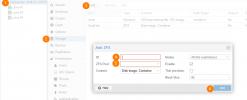Ok, I managed to created a zfs pool finally.
Here is my zfs pool setup:
I know, it is not a big amount of available space , but I am just learning and testing now. So, it is not a big deal.
I backupped all my VMS before I added the new disks in my server, formatted the new disks, and created the pool.
I then saved via ftp the entire "dump" folder on another PC. In this folder there are ZST files, log files and a .dat file (by the way, what is it? Do I need it to restore my VMs?)
So, I want now to create a 200 GB size "space" to restore and run my backupped VMs, a 300 GB storage where I can backupthem when needed, a 100 GB size space for my ISO, and a last one made of the rest which I can use as an added disk for my linux machine VM.
What exactly should I do? Could you help me figure this out please?
Thanks
Here is my zfs pool setup:
Code:
root@pve:~# zpool status
pool: lukepool
state: ONLINE
scan: none requested
config:
NAME STATE READ WRITE CKSUM
lukepool ONLINE 0 0 0
raidz1-0 ONLINE 0 0 0
sda ONLINE 0 0 0
sdb ONLINE 0 0 0
sdc ONLINE 0 0 0
errors: No known data errors
root@pve:~# zfs list
NAME USED AVAIL REFER MOUNTPOINT
lukepool 480K 898G 128K /lukepoolI know, it is not a big amount of available space , but I am just learning and testing now. So, it is not a big deal.
I backupped all my VMS before I added the new disks in my server, formatted the new disks, and created the pool.
I then saved via ftp the entire "dump" folder on another PC. In this folder there are ZST files, log files and a .dat file (by the way, what is it? Do I need it to restore my VMs?)
So, I want now to create a 200 GB size "space" to restore and run my backupped VMs, a 300 GB storage where I can backupthem when needed, a 100 GB size space for my ISO, and a last one made of the rest which I can use as an added disk for my linux machine VM.
What exactly should I do? Could you help me figure this out please?
Thanks



